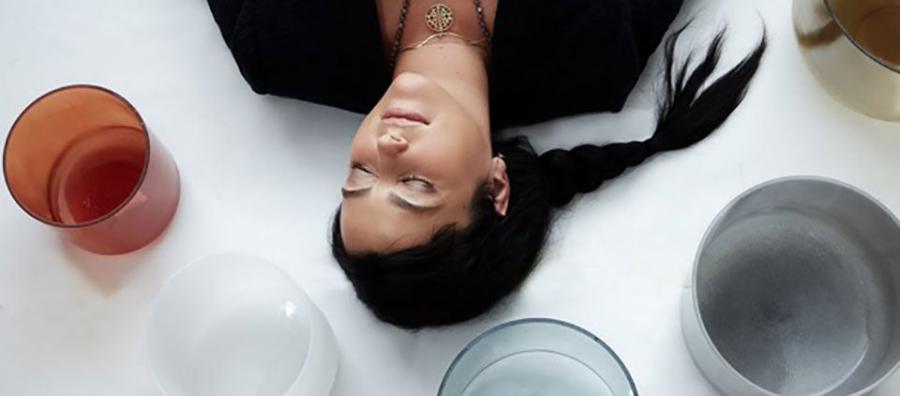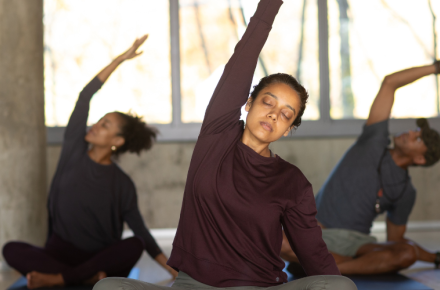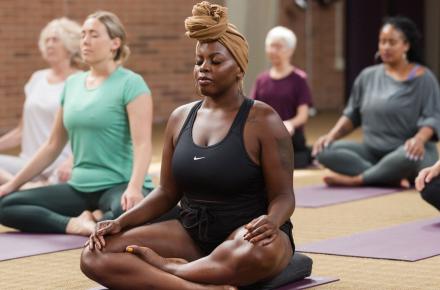The Harmonic Experience of Sound Meditation


Whenever I attempt to commit to a regular meditation practice, I come up against the same wall: It’s really hard for me to sit motionless for stretches of time and observe my breath in silence. Eventually, the nothingness is more than I can bear. When I engage in guided meditation, though—when someone or something leads me through a meditation and helps me focus on my breath, sink into myself, and simply rest in the present moment—I have a much easier time of it. My mind needs something to do, even if it’s just listening passively to a prompt.
To support people like me, Sara Auster, a sound therapist and meditation teacher, crafts experiences that use sound as a tool to help people access meditative states, deeply relax, practice self-inquiry, and catalyze change. Whereas guided meditation often uses verbal cues, Sara’s “cues” are overtone-emitting instruments, such as tuning forks, gongs, shruti boxes, Himalayan and crystal singing bowls, chimes, and the human voice.
“Listening to this particular type of atonal sound,” she explains, “helps facilitate awareness of the present moment. The sound is 'guiding' the meditation. Engaging in a practice of deep listening has the ability to impact your overall well-being, bringing balance, relaxation, and a sense of wholeness to the body.”
The atonal sound experiences Sara is describing are called Sound Baths. Lying down or seated in a comfortable position—often wearing a blanket and an eye mask—people simply listen and absorb. Sara begins by leading participants in a few minutes of guided focus on the breath, and then introduces different sounds and frequencies in succession. She encourages “sound bathers” to allow the sounds to anchor them in the present moment, suggesting that it’s best not to get caught up in judging or analyzing the sounds. She merely recommends that people listen, observe, and experience.
“The sound of harmonic vibrations created by singing bowls, gongs, and other overtone-emitting instruments is intended to stimulate the alpha and theta brain waves,” she explains. “These waves are associated with deep meditative and peaceful states that are highly conducive to healing.” By using particular combinations of rhythms and frequencies, Sara can help people shift from the normal beta state (alert, concentrating, reacting) to alpha (creative, relaxed) to theta (meditative state) and even delta (deep sleep, where restoring and healing can occur). “Sound slows down the heart and respiratory rate,” she adds, “creating a therapeutic effect on the mind and body.”
Sara believes that Sound Baths can be helpful for anyone who wants to relax or access the benefits of meditation. “A Sound Bath is an opportunity to explore what a meditative state is and how it feels,” she says. “For this reason, it can be beneficial for both beginning and experienced meditators, as well. The goal of the experience is to invite deep rest and relaxation, and explore self-inquiry and self-discovery.”
Sound has also been used therapeutically for centuries to retune, realign, and harmonize trauma or imbalances on the physical, mental, or emotional levels. “Sound and vibration can help alleviate pain and discomfort,” Sara notes, pointing out that sound is especially effective at alleviating stress, insomnia, and headaches, but that it’s also useful in quieting the mind, managing depression and anxiety, reducing the effects of trauma, releasing undesirable thoughts and habits, increasing self-confidence, and enhancing the ability to listen, pay greater attention to detail, and, of course, meditate.
According to Sara, one of the most powerful effects of using sound to meditate, or as therapy, is the transformation of consciousness. “Consciousness is the state of being awake and aware of your surroundings,” she says. “By listening deeply, with focus, without distraction, you shift and expand your level of awareness of yourself and your relationship to the world around you.”
Find out about Sara Auster's Sound Bath Immersion program at Kripalu.
Listen to one of Sara’s Sound Bath experiences on Spotify.
Portland Helmich has been investigating natural health and healing as a host, reporter, writer, and producer for more than 15 years.
© Kripalu Center for Yoga & Health. All rights reserved. To request permission to reprint, please email editor@kripalu.org.













































